Learning Outcomes
By the end of this section, you will be able to:
- Use the Law of Sines to solve oblique triangles.
- Find the area of an oblique triangle using the sine function.
- Solve applied problems using the Law of Sines.
Suppose two radar stations located 20 miles apart each detect an aircraft between them. The angle of elevation measured by the first station is 35 degrees, whereas the angle of elevation measured by the second station is 15 degrees. How can we determine the altitude of the aircraft? We see in Figure 1 that the triangle formed by the aircraft and the two stations is not a right triangle, so we cannot use what we know about right triangles. In this section, we will find out how to solve problems involving non-right triangles.

Figure 1
Using the Law of Sines to Solve Obliques Triangles
In any triangle, we can draw an altitude, a perpendicular line from one vertex to the opposite side, forming two right triangles. It would be preferable, however, to have methods that we can apply directly to non-right triangles without first having to create right triangles.
Any triangle that is not a right triangle is an oblique triangle. Solving an oblique triangle means finding the measurements of all three angles and all three sides. To do so, we need to start with at least three of these values, including at least one of the sides. We will investigate three possible oblique triangle problem situations:
- ASA (angle-side-angle) We know the measurements of two angles and the included side. See Figure 2.

Figure 2
- AAS (angle-angle-side) We know the measurements of two angles and a side that is not between the known angles. See Figure 3.

Figure 3
- SSA (side-side-angle) We know the measurements of two sides and an angle that is not between the known sides. See Figure 4.

Figure 4
Knowing how to approach each of these situations enables us to solve oblique triangles without having to drop a perpendicular to form two right triangles. Instead, we can use the fact that the ratio of the measurement of one of the angles to the length of its opposite side will be equal to the other two ratios of angle measure to opposite side. Let’s see how this statement is derived by considering the triangle shown in Figure 5.

Figure 5
Using the right triangle relationships, we know that [latex]\sin \alpha =\frac{h}{b}[/latex] and [latex]\sin \beta =\frac{h}{a}[/latex]. Solving both equations for [latex]h[/latex] gives two different expressions for [latex]h[/latex].
We then set the expressions equal to each other.
Similarly, we can compare the other ratios.
Collectively, these relationships are called the Law of Sines.
Note the standard way of labeling triangles: angle [latex]\alpha[/latex] (alpha) is opposite side [latex]a[/latex]; angle [latex]\beta[/latex] (beta) is opposite side [latex]b[/latex]; and angle [latex]\gamma[/latex] (gamma) is opposite side [latex]c[/latex]. See Figure 6.
While calculating angles and sides, be sure to carry the exact values through to the final answer. Generally, final answers are rounded to the nearest tenth, unless otherwise specified.
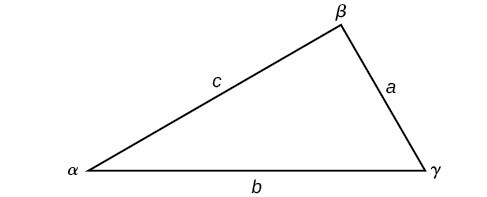
Figure 6
A General Note: Law of Sines
Given a triangle with angles and opposite sides labeled as in Figure 6, the ratio of the measurement of an angle to the length of its opposite side will be equal to the other two ratios of angle measure to opposite side. All proportions will be equal. The Law of Sines is based on proportions and is presented symbolically two ways.
[latex]\frac{\sin \alpha }{a}=\frac{\sin \beta }{b}=\frac{\sin \gamma }{c}[/latex]
[latex]\frac{a}{\sin \alpha }=\frac{b}{\sin \beta }=\frac{c}{\sin \gamma }[/latex]
To solve an oblique triangle, use any pair of applicable ratios.
Example 1: Solving for Two Unknown Sides and Angle of an AAS Triangle
Solve the triangle shown in Figure 7 to the nearest tenth.
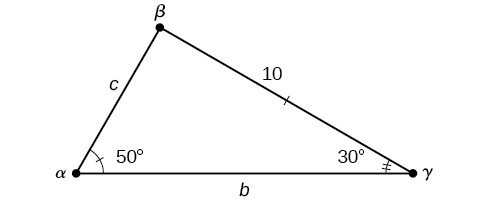
Figure 7
Try It
Solve the triangle shown in Figure 8 to the nearest tenth.
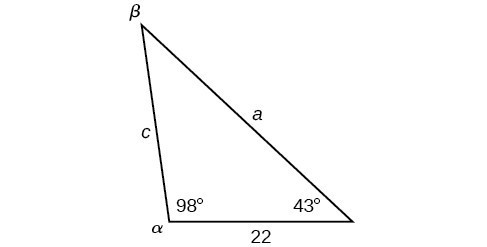
Figure 8
Try It
Using The Law of Sines to Solve SSA Triangles
We can use the Law of Sines to solve any oblique triangle, but some solutions may not be straightforward. In some cases, more than one triangle may satisfy the given criteria, which we describe as an ambiguous case. Triangles classified as SSA, those in which we know the lengths of two sides and the measurement of the angle opposite one of the given sides, may result in one or two solutions, or even no solution.
A General Note: Possible Outcomes for SSA Triangles
Oblique triangles in the category SSA may have four different outcomes. Figure 9 illustrates the solutions with the known sides [latex]a[/latex] and [latex]b[/latex] and known angle [latex]\alpha[/latex].
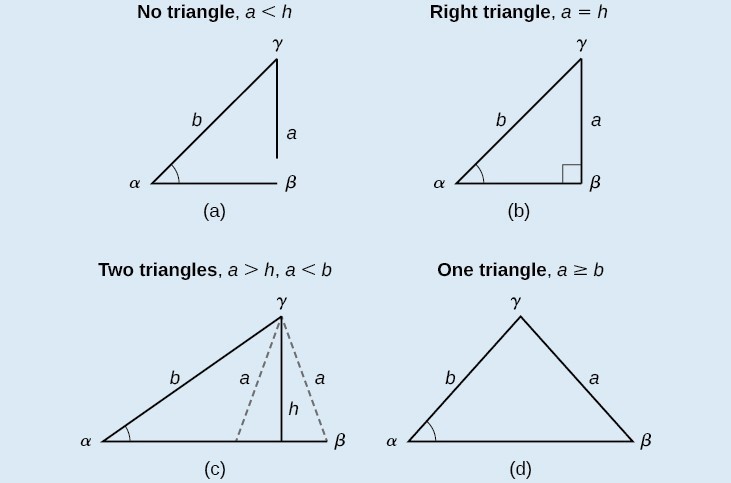
Figure 9
Example 2: Solving an Oblique SSA Triangle
Solve the triangle in Figure 10 for the missing side and find the missing angle measures to the nearest tenth.
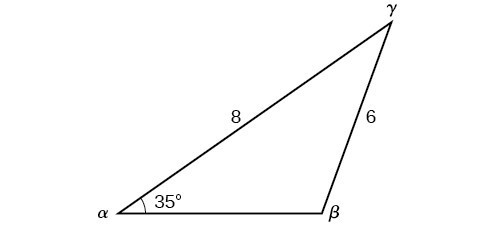
Figure 10
Try It
Given [latex]\alpha =80^\circ ,a=120[/latex], and [latex]b=121[/latex], find the missing side and angles. If there is more than one possible solution, show both.
Example 3: Solving for the Unknown Sides and Angles of a SSA Triangle
In the triangle shown in Figure 13, solve for the unknown side and angles. Round your answers to the nearest tenth.
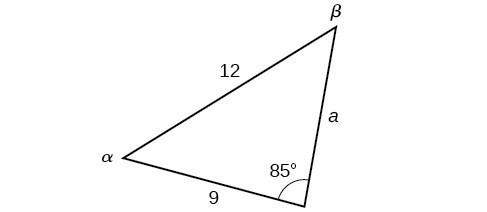
Figure 13
Try It
Given [latex]\alpha =80^\circ ,a=100,b=10[/latex], find the missing side and angles. If there is more than one possible solution, show both. Round your answers to the nearest tenth.
Example 4: Finding the Triangles That Meet the Given Criteria
Find all possible triangles if one side has length 4 opposite an angle of 50°, and a second side has length 10.
Try It
Determine the number of triangles possible given [latex]a=31,b=26,\beta =48^\circ[/latex].
Try It
Finding the Area of an Oblique Triangle Using the Sine Function
Now that we can solve a triangle for missing values, we can use some of those values and the sine function to find the area of an oblique triangle. Recall that the area formula for a triangle is given as [latex]\text{Area}=\frac{1}{2}bh[/latex], where [latex]b[/latex] is base and [latex]h[/latex] is height. For oblique triangles, we must find [latex]h[/latex] before we can use the area formula. Observing the two triangles in Figure 15, one acute and one obtuse, we can drop a perpendicular to represent the height and then apply the trigonometric property [latex]\sin \alpha =\frac{\text{opposite}}{\text{hypotenuse}}[/latex] to write an equation for area in oblique triangles. In the acute triangle, we have [latex]\sin \alpha =\frac{h}{c}[/latex] or [latex]c\sin \alpha =h[/latex]. However, in the obtuse triangle, we drop the perpendicular outside the triangle and extend the base [latex]b[/latex] to form a right triangle. The angle used in calculation is [latex]{\alpha }^{\prime }[/latex], or [latex]180-\alpha[/latex].

Figure 15
Thus,
Similarly,
A General Note: Area of an Oblique Triangle
The formula for the area of an oblique triangle is given by
[latex]\begin{align}\text{Area}&=\frac{1}{2}bc\sin \alpha \\ &=\frac{1}{2}ac\sin \beta \\ &=\frac{1}{2}ab\sin \gamma \end{align}[/latex]
This is equivalent to one-half of the product of two sides and the sine of their included angle.
Example 5: Finding the Area of an Oblique Triangle
Find the area of a triangle with sides [latex]a=90,b=52[/latex], and angle [latex]\gamma =102^\circ[/latex]. Round the area to the nearest integer.
Try It
Find the area of the triangle given [latex]\beta =42^\circ ,a=7.2\text{ft},c=3.4\text{ft}[/latex]. Round the area to the nearest tenth.
Try It
Solving Applied Problems Using the Law of Sines
The more we study trigonometric applications, the more we discover that the applications are countless. Some are flat, diagram-type situations, but many applications in calculus, engineering, and physics involve three dimensions and motion.
Example 6: Finding an Altitude
Find the altitude of the aircraft in the problem introduced at the beginning of this section, shown in Figure 16. Round the altitude to the nearest tenth of a mile.

Figure 16
Try It
The diagram shown in Figure 17 represents the height of a blimp flying over a football stadium. Find the height of the blimp if the angle of elevation at the southern end zone, point A, is 70°, the angle of elevation from the northern end zone, point [latex]B[/latex], is 62°, and the distance between the viewing points of the two end zones is 145 yards.
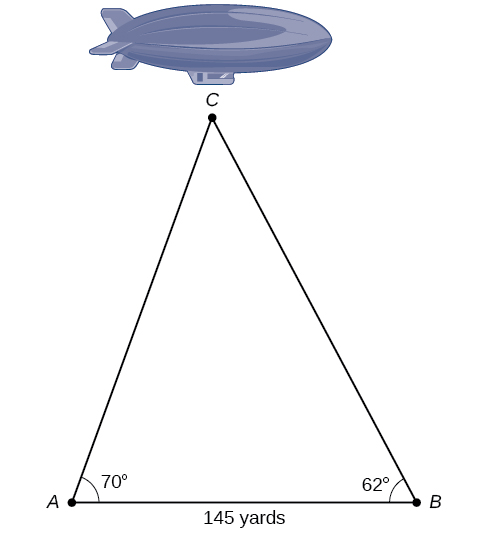
Figure 17
Try It
Key Equations
| Law of Sines |
[latex]\frac{\sin \alpha }{a}=\frac{\sin \beta }{b}=\frac{\sin \gamma }{c}[/latex] [latex]\frac{a}{\sin \alpha }=\frac{b}{\sin \beta }=\frac{c}{\sin \gamma }[/latex] |
| Area for oblique triangles | [latex]\begin{align}\text{Area}&=\frac{1}{2}bc\sin \alpha \\ &=\frac{1}{2}ac\sin \beta \\ &=\frac{1}{2}ab\sin \gamma \end{align}[/latex] |
Key Concepts
- The Law of Sines can be used to solve oblique triangles, which are non-right triangles.
- According to the Law of Sines, the ratio of the measurement of one of the angles to the length of its opposite side equals the other two ratios of angle measure to opposite side.
- There are three possible cases: ASA, AAS, SSA. Depending on the information given, we can choose the appropriate equation to find the requested solution.
- The ambiguous case arises when an oblique triangle can have different outcomes.
- There are three possible cases that arise from SSA arrangement—a single solution, two possible solutions, and no solution.
- The Law of Sines can be used to solve triangles with given criteria.
- The general area formula for triangles translates to oblique triangles by first finding the appropriate height value.
- There are many trigonometric applications. They can often be solved by first drawing a diagram of the given information and then using the appropriate equation.
-
-
Glossary
- altitude
- a perpendicular line from one vertex of a triangle to the opposite side, or in the case of an obtuse triangle, to the line containing the opposite side, forming two right triangles
- ambiguous case
- a scenario in which more than one triangle is a valid solution for a given oblique SSA triangle
- Law of Sines
- states that the ratio of the measurement of one angle of a triangle to the length of its opposite side is equal to the remaining two ratios of angle measure to opposite side; any pair of proportions may be used to solve for a missing angle or side
- oblique triangle
- any triangle that is not a right triangle
-
Candela Citations
- Precalculus. Authored by: OpenStax College. Provided by: OpenStax. Located at: http://cnx.org/contents/fd53eae1-fa23-47c7-bb1b-972349835c3c@5.175:1/Preface. License: CC BY: Attribution


